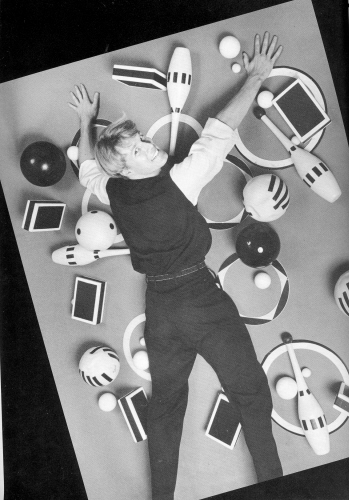|
Nizer's Last
Minute Decision
Proves Fruitful
|
The
1990 US Nationals Championship will undoubtedly go down in the
books as one of the best overall displays of juggling
talent. Eight
competitors each performed high-quality shows and entertained the
audience with a wide range of props, styles and
presentations. The champion,
Mark Nizer, became king of the hill for l990 using the talent
he has developed during the last 15 years, and more
importantly, the experience of more than 10 years of performing.
"The
real
advantage I thought I had was that I am a professional
and I perform every day," he said. "I do a lot of stage
shows so I'm used to that environment and I immediately felt
at home.
But I think the points in performance were more important than
anything else because, obviously, everyone was doing all this
fantastic stuff."
Performing
well in the competition and rising above the others was a
difficult task for Nizer, one that was made even more taxing
by the fact that he did not decide to compete until two days
before the championship. Using only a few of his props
and a borrowed Janet Jackson tape (a contrast to the classical
music he normally uses) he was able to get through the preliminaries
and into the show.
Nizer
said he had little difficulty deciding what
to use for his seven-minute competition routine.
"You know what jugglers like. And
I wanted to do a little talking because
it makes me relaxed, and it takes the bite
off the audience," he said. He opened
with three balls, performing a smooth,
jazz-inspired routine to classical music. Next came a headroll
routine which began by throwing one of the three soft balls
high into the
air straight to a series of head bounces.
Perhaps the most impressive trick of Nizer's show came
next. He performed a backroll
while spinning a ball on
each of his index fingers and another
on a mouthstick.
Nizer
followed the backroll with
a routine inspired by one of
his juggling idols, Trixie Larue.
He juggled four rings and
a volleyball, performing a series of head bounces with the
ball, and placing the
rings around his neck.
|
Nizer
wanted to perform the trick as something of a tribute
to Trixie, but in hindsight, he admits that may have
been a poor choice. "That was a bad move. I
shouldn't have done it, because it's pretty new and I'm
not really confident with it. But I got lucky."
He ended with three clubs, a decision which was
inspired by the fact
he'd been working on a cruise ship for six
weeks, which had left his four-club routine and all of
his high tricks quite rough. The one exception though
was the backcross pirouette which he used as his final
trick. "I hadn't done that in six weeks, but I
had to do it because I gagged
it in '84," he said.
The
desire to win and avenge his loss in 1984 added a little
pressure to the competition for Nizer. But what
added even more was what losing might mean, given his
status as a professional performer. "My ego was
on the line. It's really scary, when you're doing this
for a living, to put your reputation on the line and
compete. That's why I think
a lot of professionals
don't enter, because there's a big risk if you
don't win," he said.
But
while the competition may have been somewhat
stressful, Nizer's overall experience at the festival
was anything but. Having been away from the scene for
six years, he was pleased to renew and start
friendships. He said, "A
lot of these people I've known for 12 years.
It's really strange to see them, and how we've all changed
through the years, and how we haven't changed.
It's like coming home to a big family."
|
He
was immediately interested in getting caught up on the
development of the organization, and is very interested in the
discussion of changing the format of the championships.
"The IJA was my whole reason for juggling when I was a
kid," he said. "I juggled for the championships, so
that I could do better and compete." |

